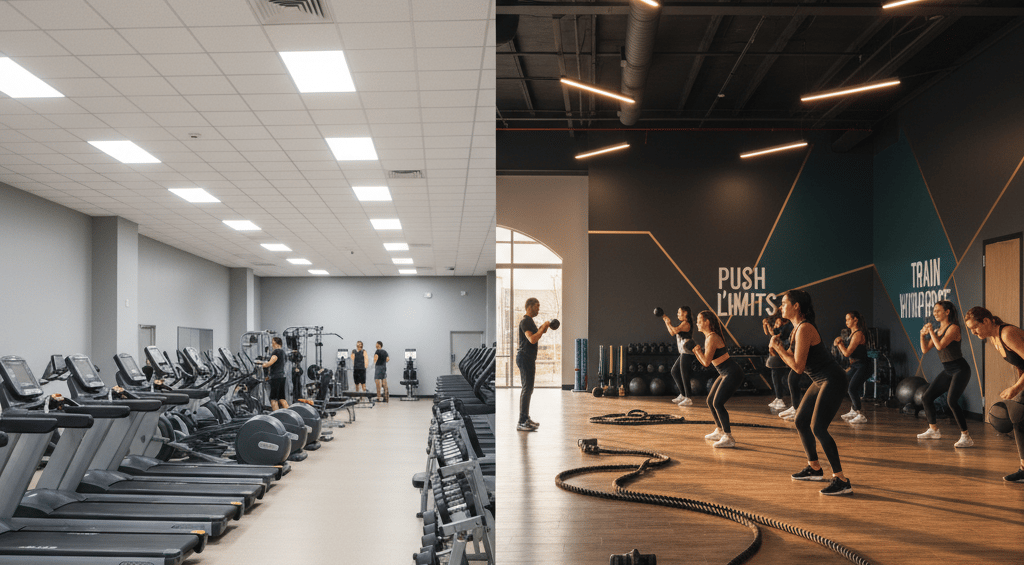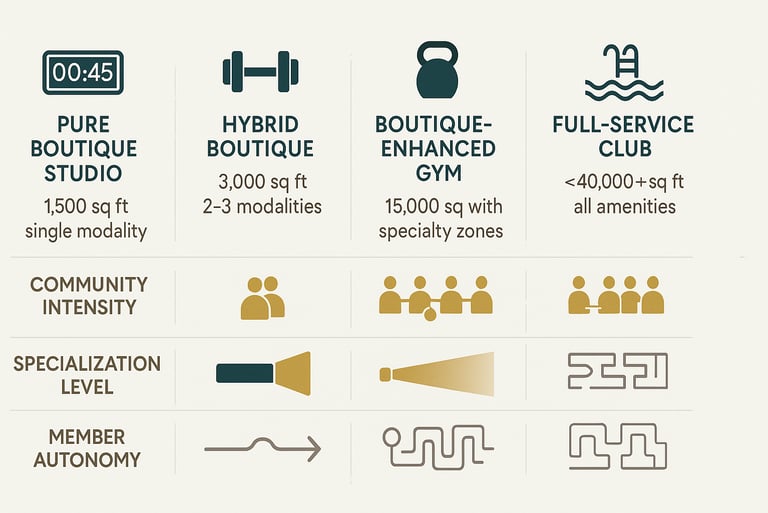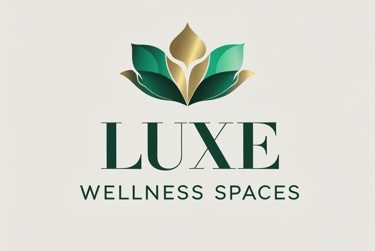Boutique Fitness vs Big-Box Gyms: Build Member Loyalty Fast
Learn how boutique studios win loyalty and what big gyms can steal. Practical strategies to create authentic wellness experiences members love.
Daryn Berriman
9/30/20259 min read


The fitness industry is shifting toward experience-driven models where boutique studios consistently outperform traditional gyms in member retention by creating specialized, community-focused environments. Large fitness centers can compete by borrowing boutique strategies like dedicated wellness zones, signature class formats, and clear brand narratives while leveraging their scale advantages of space, variety, and resources to deliver personalized experiences at volume.
Five Key Facts:
Boutique fitness studios average 75-80% member retention versus 50-60% for big-box gyms (IHRSA Global Report, March 2024)
Specialized fitness formats grew 121% between 2019-2024 while traditional gym memberships declined 8% (Club Industry Trend Report, January 2025)
Members pay 30-50% premium prices for boutique experiences that emphasize community and coaching (Mindbody Wellness Index, September 2024)
68% of gym-goers cite lack of personal connection as their primary reason for canceling memberships (Les Mills Global Fitness Report, November 2024)
Hybrid facilities combining boutique zones within larger gyms see 40% higher lifetime member value (Fitness Business Association, December 2024)
Walk into most big-box gyms and you will feel it immediately. Rows of treadmills facing wall-mounted TVs. Generic playlists. Members moving through routines alone, earbuds in, eyes down. Now visit a boutique spin studio or CrossFit box. The energy hits differently. Coaches greet you by name. Strangers high-five after class. The lighting, music, and layout all tell a story.
This is not about square footage or equipment budgets. It is about how a space makes people feel.
Boutique fitness studios dominate member loyalty because they nail three fundamentals: community, specialization, and sensory experience. They create tribes around specific fitness philosophies. They design every touchpoint to reinforce their brand story. They make members feel seen.
Big-box gyms have struggled to compete on experience, even though they excel in variety, space, and amenities. But here is the good news. Large facilities can borrow boutique strategies without abandoning their scale advantages. The solution is not choosing between boutique intimacy and big-box resources. It is blending both models strategically.
Think of it as creating boutique moments within a larger ecosystem. A meditation corner that feels like a private sanctuary. A functional training zone with dedicated coaches who run small-group sessions. Signature class formats that become your facility's calling card. When you segment your space and programming thoughtfully, members get personalized experiences without sacrificing access to pools, courts, childcare, and full equipment ranges that only larger facilities can offer.
What Boutiques Get Right
Boutique studios win by going narrow and deep. SoulCycle built an empire around 45-minute indoor cycling classes. Barry's Bootcamp owns high-intensity interval training in a red-lit room. Orangetheory trademarked heart-rate zone training with live performance tracking.
This specialization creates clarity. Members know exactly what they are signing up for. The brand promise is simple and delivered consistently. Everyone in the room shares a common goal and method.
Community develops naturally when programming stays focused. You see the same faces in the 6am class. Instructors learn your name and your limits. Inside jokes emerge. WhatsApp groups form. This tribal feeling keeps members showing up even when motivation dips.
The physical environment reinforces everything. Lighting sets the mood. Music choices align with the workout intensity. Equipment placement encourages interaction. Temperature, scent, and acoustics all get attention. Nothing feels accidental.
Where Big Gyms Have the Edge
Large fitness centers offer something boutiques cannot match: comprehensive wellness under one roof. Strength training, cardio, pools, courts, spa services, nutrition counseling, physical therapy. Members can cross-train, switch routines when they plateau, and bring family members with different fitness levels.
This variety matters for retention. Members who use three or more facility areas stay 65% longer than single-activity users according to the Club Industry Benchmarking Report from August 2024. When your shoulder injury prevents lifting, you can swim. When you get bored with spin, you try kickboxing. The facility grows with you.
Big gyms also have space to experiment. They can test new formats without risking their entire business model. A boutique spin studio cannot easily pivot to yoga. A 40,000 square foot facility can add a yoga room, measure uptake, and adjust.
Budget advantages allow better instructor recruitment, facility maintenance, and technology investments. Those digital workout tracking systems and recovery lounges cost real money.
The Hybrid Solution
The smartest large facilities are creating boutique experiences within their footprint. Here is how it works in practice.
Equinox carved out dedicated studio spaces inside their clubs for signature classes like Precision Running and The Pursuit cycling. Members book these experiences separately. The rooms have distinct design schemes. Instructors specialize in that format only. It feels like a boutique embedded in a gym.
Life Time Fitness created Alpha zones for functional training with dedicated coaches who run small-group sessions. The space uses different flooring, has its own equipment set, and operates on a semi-private model even though it sits inside a massive facility.
Virgin Active in the UK and South Africa introduced Red Rooms for HIIT classes with theatrical lighting and concert-quality sound systems. Members enter a different world for 30 minutes before returning to the broader gym.
Case Study: From Generic to Magnetic
A 35,000 square foot gym in Austin, Texas was bleeding members in 2022. Their response demonstrates this hybrid approach perfectly.
They sectioned off 2,000 square feet for a dedicated Olympic lifting zone with specialized coaching. They converted an unused squash court into a hot yoga studio with infrared heating and salt therapy. They hired a running coach to lead 6am track workouts that built a loyal community.
Results after 18 months: member retention jumped from 58% to 79%. New memberships increased 34%. Most significantly, average revenue per member rose 42% as people added specialty programming to base memberships.
The facility did not reduce equipment variety or cut general gym access. They added focused experiences that created emotional connection points.
The Contrarian Take
Not every gym needs to act like a boutique. Some members actively avoid the community-building, high-energy vibe that boutiques push. They want anonymous workouts. They prefer exploring their own routines without coached classes or group dynamics.
These members choose big gyms specifically because they are not boutiques. They value open gym time, equipment abundance, and the freedom to show up without commitment to a class schedule or social scene.
The key is knowing your positioning. If you try to be everything, you become nothing. A luxury wellness resort should absolutely create boutique-like experiences because their guests expect transformation and immersion. A budget-focused facility serving price-conscious exercisers should lean into convenience and access rather than trying to manufacture community.
Match your approach to your member profile and price point. Authenticity matters more than copying trends.
Your Implementation Checklist
Review your current member journey:
How many touchpoints feel personal versus transactional?
Do members encounter the same staff regularly?
Can instructors greet regulars by name?
Does your space have distinct zones with different energy?
What story does your design tell?
Audit your class programming:
Do you have signature formats unique to your facility?
Are instructors specialists or generalists?
Could members describe your fitness philosophy clearly?
Do class formats align with your brand positioning?
Evaluate your physical spaces:
Which areas feel generic?
Where could you create boutique moments?
What underused spaces could transform with new purpose?
Does lighting, music, and layout support your intended vibe?
Test one boutique zone:
Start small with 1,000-2,000 square feet
Choose a specific fitness modality
Hire specialist instructors
Design the space distinctly
Measure retention and revenue impact before scaling


Try This in 5 Minutes
Walk through your facility as a first-time visitor right now:
Enter through the main door and notice what you see, hear, and smell in the first 30 seconds. Does it communicate your brand promise or feel generic?
Count how many staff interactions you observe. Are they transactional check-ins or genuine connections?
Stand in your largest workout space and assess whether design elements tell a story or simply fill space efficiently.
Write down three immediate changes you could make this week to create more intentional experiences. Small shifts in lighting, music selection, or staff engagement protocols often deliver outsized impact.
Common Mistakes and Fixes
Mistake: Copying boutique aesthetics without changing the service model. Fix: Train staff on community building first. Design follows culture, not the reverse.
Mistake: Launching too many specialty formats at once. Fix: Perfect one signature offering before expanding. Depth beats breadth for brand clarity.
Mistake: Charging boutique prices without delivering boutique experiences. Fix: Start with experience upgrades, then adjust pricing after proving value.
Mistake: Assuming all members want community and coaching. Fix: Create both high-touch boutique zones and low-touch open gym areas.
Mistake: Under-investing in instructor development. Fix: Specialist instructors command premium loyalty. Budget accordingly for training and retention.
Your Brand Story Matters Most
Whether you operate a 2,000 square foot yoga studio or a 100,000 square foot resort wellness center, clarity wins. Members do not choose facilities based on equipment lists. They choose transformation stories that resonate with their identity.
SoulCycle sells empowerment through cycling. CrossFit sells competitive community. Equinox sells high-performance lifestyle. Each brand communicates a clear mission that attracts dedicated followers.
What story does your facility tell? Can a prospective member articulate it after visiting your website and space? Does every decision from playlist selection to locker room design reinforce that narrative?
Boutique studios succeed because their story stays focused and every element aligns. Big gyms can do the same by defining their unique positioning and creating experiences that deliver on that promise consistently.
The fitness industry is not splitting into boutique versus big-box camps. It is evolving toward experience-driven models at every scale. Facilities that understand this shift and act accordingly will build loyal communities regardless of square footage.
Take the Next Step
Creating wellness experiences that members crave requires strategic thinking about space design, programming, branding, and operations. Whether you are retrofitting an existing facility or planning a new build, the details matter enormously.
Do you require specialist assistance with a new wellness project, or seeking to improve the operation of your existing space? Book a free strategy call and let our team help you design experiences that transform members into advocates.
FAQ's
Q: What is the main difference between boutique fitness studios and big-box gyms?
A: Boutique studios specialize in one or two specific fitness modalities like cycling, HIIT, or yoga, creating focused communities around that discipline. Big-box gyms offer comprehensive fitness options including cardio equipment, weights, pools, courts, and classes under one roof. Boutiques typically emphasize coached experiences and community building while larger gyms prioritize variety and member independence.
Q: Can large gyms compete with boutique studios on member experience?
A: Yes, large gyms can create boutique-quality experiences by designating specialized zones within their facility for specific training methods, hiring specialist instructors, and designing these areas with distinct aesthetics and programming. The key is creating focused experiences that feel intimate and community-driven while maintaining the variety advantages that large spaces provide.
Q: Why do boutique studios have better member retention rates?
A: Boutique studios average 75-80% retention versus 50-60% for traditional gyms because they build strong communities around specialized training methods. Members develop relationships with instructors who know their names and regular classmates who create accountability. The focused programming and consistent brand experience also reduce decision fatigue and create clear expectations.
Q: What can big gyms learn from boutique fitness?
A: Large facilities should adopt signature class formats that become their calling card, train staff to build genuine member relationships, create distinct zones with intentional design rather than generic layouts, develop a clear brand story beyond just equipment access, and consider semi-private or small-group training options that deliver personalized attention.
Q: Should every gym try to create a boutique feel?
A: No, some members specifically choose larger gyms because they prefer anonymous workouts without mandatory community involvement or class schedules. The key is knowing your target member profile and aligning your experience design with their preferences. Budget-focused facilities serving convenience-minded exercisers should not force boutique-style community building.
Q: How much space do you need to create a boutique zone inside a larger gym?
A: Most successful boutique zones within larger facilities range from 1,000 to 2,500 square feet. This provides enough room for small-group training of 8-15 people with specialized equipment while creating a distinct atmosphere separate from the main gym floor. Even a 1,000 square foot space can deliver intimate, focused experiences when designed intentionally.
Q: What is the ROI of adding boutique experiences to a traditional gym?
A: Facilities that successfully integrate boutique zones typically see 15-25% increases in member retention and 30-50% growth in revenue per member through specialty program add-ons. Implementation costs vary widely based on space conversion needs and equipment, but many gyms report positive ROI within 12-18 months based on improved retention alone.
Q: Do wellness resorts and hotels need different strategies than standalone gyms?
A: Yes, resort and hotel fitness facilities should lean heavily into boutique-style experiences because guests expect immersive, transformation-focused programming during their stays. These environments benefit from signature classes, specialized coaching, and carefully curated wellness journeys rather than open gym access. The goal is creating memorable experiences that justify premium pricing.
Further reading on our blog: 'Hotel Wellness ROI: Proven Revenue Impact.'
• Explore our Spa & Wellness Consultancy to scope project phases and services.
• See how we structure Fitness and Leisure concepts before you commit to equipment.
• Developers and luxury homeowners can review Home Wellness Spaces for private suites and villas.
• Learn why Luxe Wellness Spaces blends design, operations, and growth under one roof.
• View a Concept-to-Launch case study that hit break-even in 90 days.
About The Author
Daryn Berriman is the Founder and Principal Consultant of Luxe Wellness Spaces, a consulting-led studio blending operational expertise and design excellence to create wellness businesses that perform, and spaces that guests love.


